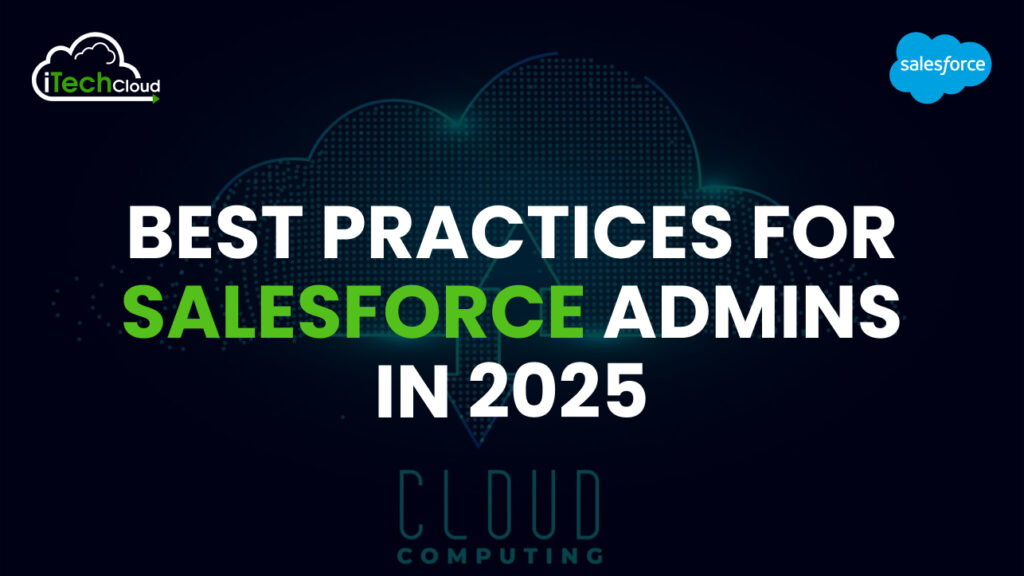Best Practices for Salesforce Admins in 2025

Salesforce administrators play a crucial role in ensuring that organizations get the most out of their CRM system. As technology continues to evolve, so do the responsibilities of a Salesforce admin. In 2025, best practices for Salesforce admins encompass new security standards, automation trends, user management strategies, and emerging features. This blog provides a detailed guide to the best practices every Salesforce administrator should follow to enhance efficiency and maximize value.
Table of Contents
1. Stay Updated with Salesforce Releases
Salesforce updates its platform three times a year (Spring, Summer, and Winter releases). Staying informed about these updates is essential to leverage new features and improvements. Admins should:
- Subscribe to Salesforce Release Notes.
- Participate in Trailhead modules related to new updates.
- Join the Salesforce community to discuss changes and implementation strategies.
- Test new features in a sandbox environment before deploying them to production.
2. Prioritize Security and Compliance
With increasing cybersecurity threats, securing Salesforce data is more critical than ever. Admins should:
- Implement multi-factor authentication (MFA) for all users.
- Regularly review and refine user permissions following the Principle of Least Privilege (PoLP).
- Conduct security health checks using Salesforce’s built-in tools.
- Stay compliant with industry regulations such as GDPR, HIPAA, or CCPA by reviewing data retention policies and enabling audit logs.
3. Automate Workflows with Flow
Salesforce Flow is now the go-to automation tool, replacing older automation tools like Workflow Rules and Process Builder. Admins should:
- Convert existing workflow rules and Process Builder automations into Flows.
- Use Record-Triggered Flows to optimize business processes.
- Leverage scheduled and auto-launched flows for background automation.
- Monitor Flow performance and debugging logs to ensure optimal execution.
4. Optimize Data Management
Effective data management leads to better reporting and decision-making. Admins should:
- Regularly run data deduplication processes using tools like Duplicate Rules or third-party apps.
- Implement data validation rules to maintain high-quality records.
- Use Data Loader, Import Wizard, or Salesforce APIs for bulk data imports/exports.
- Archive outdated records to optimize system performance and storage.
5. Improve User Adoption and Training
A well-trained user base leads to higher productivity and fewer support tickets. Admins should:
- Conduct periodic user training and refresher courses.
- Create and maintain Salesforce Knowledge articles for self-service.
- Set up interactive in-app guidance using Salesforce’s In-App Learning tool.
- Gather feedback through surveys to identify areas for improvement.
6. Reporting and Analytics
Admins should ensure that business leaders have access to accurate and meaningful reports. Key strategies include:
- Creating custom reports and dashboards tailored to different user roles.
- Using dynamic dashboards to personalize data views.
- Leveraging Salesforce Einstein for predictive analytics and AI-driven insights.
- Cleaning up unused reports and dashboards to maintain system efficiency.
7. Improve Integration and API Management
As organizations use multiple applications, seamless integrations with Salesforce are necessary. Best practices include:
- Using Salesforce Connect or MuleSoft for integrating external data sources.
- Ensuring API limits are not exceeded to maintain system performance.
- Keeping up-to-date with API versioning to avoid deprecated endpoints.
- Implementing OAuth authentication for secure API connections.
8. Monitor System Performance
Regularly checking system health ensures a smooth Salesforce experience. Admins should:
- Use the Salesforce Optimizer to analyze system performance and get recommendations.
- Monitor login history, API usage, and error logs to identify bottlenecks.
- Optimize page layouts and Lightning components for faster load times.
- Review system limits, such as storage and governor limits, to prevent disruptions.
9. Artificial Intelligence (AI)
Salesforce continues to integrate AI capabilities through Einstein AI. Admins should:
- Einstein Lead Scoring to help sales teams prioritize leads.
- Use Einstein Bots to enhance customer support and automate interactions.
- Explore Einstein Activity Capture for improved sales data accuracy.
- Stay updated on AI enhancements and how they can benefit the organization.
10. Maintain Documentation and Change Management
Proper documentation ensures continuity and smooth transitions. Best practices include:
- Documenting all customizations, automation processes, and integrations.
- Using a structured change management process for deployments.
- Maintaining version control using tools like Salesforce DevOps Center or Git.
- Training backup admins to prevent knowledge gaps in case of turnover.
11. Engage with the Salesforce Community
Networking with other Salesforce professionals helps admins stay ahead of trends. Ways to engage include:
- Participating in Salesforce User Groups and Community Forums.
- Attending Dreamforce and other Salesforce events.
- Earning Salesforce certifications to validate expertise.
- Contributing to open-source projects and knowledge-sharing initiatives.
Conclusion: Salesforce Admins in 2025
Salesforce Admins remain the backbone of business innovation, leveraging automation, AI, and data-driven insights to enhance efficiency. With AI-powered tools like Einstein GPT and Flow automation, admins streamline workflows and optimize CRM strategies. Continuous learning is crucial as Salesforce evolves, requiring admins to stay updated on new features and best practices. Security, integration, and user experience remain top priorities, ensuring seamless operations.

